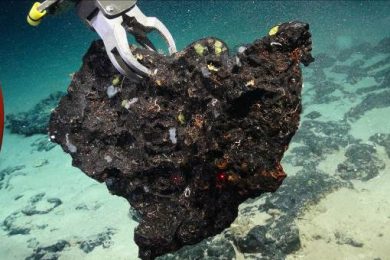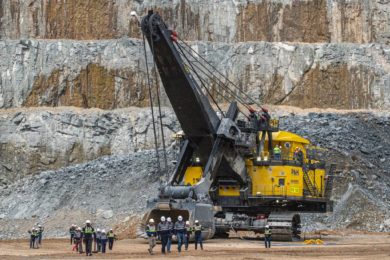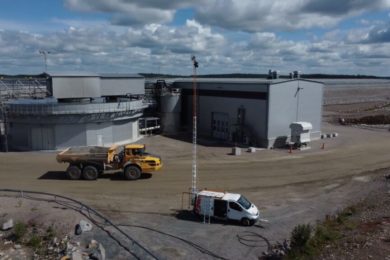Britain’s National Oceanography Centre (NOC) is engaged in research into the potential risks and benefits of exploiting deep-sea mineral resources, some of which are essential for low-carbon technology, as well as using ocean robots to estimate the environmental impact of these potential deep-sea mining activities.
Late last year the NOC led an expedition on the RRS James Cook that found enough of the scarce element tellurium present in the crust of a submerged volcano that, if it were all to be used in the production of solar PV panels, could provide two-thirds of the UK’s annual electricity supply.
The NOC investigation of a seamount more than 500 km from the Canary Islands has revealed a crust of “astonishingly rich” rock. Samples brought back to the surface contain tellurium in concentrations 50,000 times higher than in deposits on land.
The rocks also contain rare earth elements that are used in wind turbines and electronics.
Known as Tropic Seamount, the undersea mountain stands about 3,000 m tall, the BBC reports – “about the size of one of the middle-ranging Alpine summits – with a large plateau at its top, lying about 1,000 m below the ocean surface.”
Using robotic submarines, NOC researchers “found that the crust is dark and fine-grained and stretches in a layer roughly 4 cm thick over the entire surface of the mountain.
Dr Bram Murton, the leader of the expedition, told the BBC that he had been expecting to find abundant minerals on the seamount but not in such concentrations. “These crusts are astonishingly rich and that’s what makes these rocks so incredibly special and valuable from a resource perspective.”
He has calculated that the 2,670 t of tellurium on this single seamount represents 1/12th of the world’s total supply.
Recently, however, the NOC also led an international study demonstrating deep-sea nodule mining will cause long-lasting damage to deep-sea life, lasting at least for decades.
These nodules are potato-sized rocks containing high levels of metals, including copper, manganese and nickel. They grow very slowly on the sea-bed, over millions of years. Although no commercial operations exist to extract these resources, many are planned.
Professor Edward Hill, Executive Director at the NOC commented, “By 2050 there will be nine billion people on earth and attention is increasingly turning to the ocean, particularly the deep ocean, for food, clean supplies of energy and strategic minerals. The NOC is undertaking research related to many aspects and perspectives involved in exploiting ocean resources. This research is aimed at informing with sound scientific evidence the decisions that will need to be taken in the future, as people increasingly turn to the oceans to address some of society’s greatest challenges.”
Part of the NOC’s research into this area involves leading major research programs into the exploration of potential resources. This includes: seafloor massive sulphides, which provide ores rich in copper, zinc and gold, and iron-manganese crusts rich in cobalt, tellurium and rare-earth metals. NOC scientists have also carried out multiple research expeditions to study the environment around areas with resources that may be the target of future mining. This includes the Clarion-Clipperton zone in the eastern Pacific, the Mid-Atlantic Ridge and Atlantic Seamounts. This research is revealing extremely high diversities of deep-sea life, as well as a surprising variation of subsea landscapes, each containing different lifeforms.
Dr Daniel Jones from the NOC, the lead author of the study, said, “the deep-sea is a remote, cold and dark environment kilometres below the surface of the ocean, yet it is home to a wide variety of marine life, much of which is very poorly understood. This research analysed all available studies on impacts to ecosystems in nodule areas and shows mining for nodule resources on the seafloor is likely to be highly destructive in the mined area, with long lasting impacts. We also think that these studies will underestimate the impacts of mining. Many would not even represent one month’s work for a full-scale commercial operation, which might last for twenty years.
“This study helps provide the best available information on the potential impacts of mining disturbance. This information is important to inform decisions on how these mining activities should be carried out.”
The NOC led MarineETech expedition on board the RRS James Cook aimed to improve understanding of what controls the formation and accumulation of cobalt-rich crusts on seamounts. The results show the accumulation of the cobalt-rich crusts on the sea-mount depends on; the direction and strength of currents and deep-water tides, the depth of the water, and biological activity.
Murton explains the thinking behind the research: “The fate of modern civilization and our ability to secure a low-carbon future depends on the supply of raw materials including base metals and elements critical to new technologies. While the demand for raw materials has grown exponentially, the terrestrial grade has diminished and threatens global supply.”










